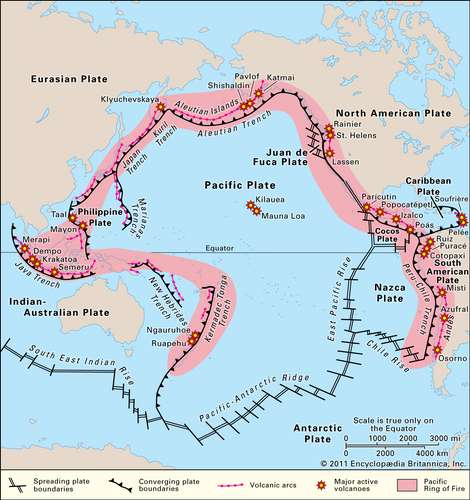- Filter By :
- Geography
- History
- Indian Heritage & Culture
- Indian Society
-
Q. Discuss the geophysical characteristics of Circum- Pacific Zone.
25 Jan, 2021 GS Paper 1 GeographyApproach:
- Start the answer by giving a brief introduction of Circum- Pacific Zone.
- Mention the salient geophysical characteristics of Circum- Pacific Zone.
- Conclude suitably.
Introduction
The Circum-Pacific Belt, also referred to as The Ring of Fire, is a path along the Pacific Ocean characterized by active volcanoes and frequent earthquakes.
Body
- Location: A nearly continuous chain of volcanoes surrounds the Pacific Ocean. The chain passes along the west coast of North and South America, from the Aleutian Islands to the south of Japan, from Indonesia to the Tonga Islands, and New Zealand.
- Formation: This Circum-Pacific chain of volcanoes (often called the Ring of Fire) and the mountain ranges associated with it owe their formation to the repeated subduction of the oceanic lithosphere beneath the continents and the islands that surround the Pacific Ocean.
- The Ring of Fire is the result of plate tectonics (Convergent, Divergent Plate Boundary, Transform Plate Boundary).
- Harbors Majority of Volcano & Earthquakes: Seventy-five percent of Earth’s volcanoes—more than 450 volcanoes—are located along the Ring of Fire.
- Ninety percent of Earth’s earthquakes occur along its path, including the planet’s most violent and dramatic seismic events.
- List of Some Volcano Circum-Pacific Belt: Mount Fuji of Japan, The Aleutian Islands of US, Krakatau Island Volcano in Indonesia, etc.
- Formation of Hot Spots: The Ring of Fire is also home to hot spots, areas deep within the Earth’s mantle from which heat rises.
- This heat facilitates the melting of rock in the brittle, upper portion of the mantle. The melted rock, known as magma, often pushes through cracks in the crust to form volcanoes.
Conclusion
As the Circum-Pacific Belt harbors the majority of global Volcanic eruptions & Earthquakes, it holds immense significance regarding the study of the earth’s interior.
To get PDF version, Please click on "Print PDF" button.
Print PDF






